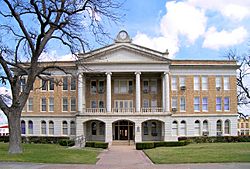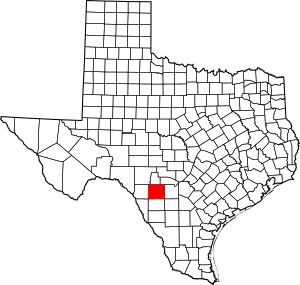Uvalde County, Texas facts for kids
Quick facts for kids
Uvalde County
|
|
|---|---|

The Uvalde County Courthouse was built in 1928 in neoclassical design. It is the fifth structure used as the county courthouse, having replaced the previous building constructed in 1890.
|
|

Location within the U.S. state of Texas
|
|
 Texas's location within the U.S. |
|
| Country | |
| State | |
| Founded | 1850 (created) 1856 (organized) |
| Named for | Juan de Ugalde |
| Seat | Uvalde |
| Largest city | Uvalde |
| Area | |
| • Total | 1,559 sq mi (4,040 km2) |
| • Land | 1,552 sq mi (4,020 km2) |
| • Water | 6.7 sq mi (17 km2) 0.4%% |
| Population
(2020)
|
|
| • Total | 24,564 |
| • Estimate
(2021)
|
24,729 |
| • Density | 15.756/sq mi (6.0835/km2) |
| Time zone | UTC−6 (Central) |
| • Summer (DST) | UTC−5 (CDT) |
| Congressional district | 23rd |
Uvalde County (pronounced yoo-VAL-dee) is a county in the state of Texas, USA. In 2020, about 24,564 people lived here. The main city and county seat is Uvalde.
The county was started in 1850 and officially organized in 1856. It is named after Juan de Ugalde, who was a Spanish governor. Reading Wood Black founded Uvalde County and the city of Uvalde.
Contents
History of Uvalde County
Early People and Explorers
People have lived in this area for a very long time, since about 7000 B.C. Native American villages were once located along the Leona River. Tribes like the Comanche, Tonkawa, Seminole, and Lipan Apache hunted and lived here. They sometimes raided settlers' homes even into the 1800s.
In 1790, Juan de Ugalde led a group to a big victory over the Apaches. This happened near where the city of Utopia is today. The area was then called Cañon de Ugalde to honor his victory.
Later, in the 1820s, a French scientist named Jean-Louis Berlandier visited the region. In the 1830s, Jim Bowie guided people looking for silver in northern Uvalde County. A trail used by the Mexican Army in 1842 also crossed through the county. This trail later became a main road to San Antonio.
First Settlements and Growth
Fort Inge was built in 1849 to help protect settlers from Native American attacks. It was also a stop for the Overland Southern Mail service.
One of the first settlers was William Washington Arnett in 1852. In 1853, Reading Wood Black bought land along the Leona River. He planned out a town called Encina in 1855, which later became Uvalde. Other settlements like Waresville and Patterson Settlement also started around this time.
In 1855, Reading Wood Black helped convince the Texas Legislature to officially create Uvalde County. The county was formally organized on May 12, 1856. Encina was chosen as the county seat on June 14. Schools were also started in the county around 1858.
After the American Civil War, Uvalde County faced many challenges. There was a lot of lawlessness and conflicts between different groups. The county even went without a sheriff for almost two years. Over time, things became more peaceful.
The first local newspapers, the Uvalde Umpire and the Hesparian, started in the late 1870s. The railroad came through the county in 1881, connecting cities like Sabinal and Uvalde. This helped the county grow and develop.
Ranching became important, with Angora goats being introduced in the 1880s. The local bee industry also became famous, winning an award at the 1900 Paris World's Fair.
Later, Garner State Park was built and opened in 1941. The National Fish Hatchery was completed in 1937. It helped produce many fish like catfish and largemouth bass. Farming also became a major part of the county's economy.
Equal Rights Efforts
From 1910, many immigrant workers helped clear land and build irrigation systems in the county. They also helped build railways and expand asphalt mines. By 1960, Mexican Americans made up about half of Uvalde County's population.
For a long time, there were laws and practices that made it hard for Mexican Americans to own land or participate fully in public life. Efforts to gain equal rights for Hispanic people in Uvalde County began with local groups.
In 1965, an integrated Catholic church was formed in Uvalde, meaning people of all backgrounds could worship together. In 1968, the Mexican American Youth Organization was formed. This led to a student walkout in 1970, where many Mexican-American students protested for better education.
Eventually, legal actions were taken to ensure that the Uvalde Consolidated Independent School District provided equal education for all students. By 2008, a settlement was reached to ensure fairness. Since then, more Mexican Americans have served in public offices in the county.
Geography
Uvalde County covers about 1,559 square miles. Most of this is land (1,552 square miles), with a small amount of water (6.7 square miles).
Main Roads
Neighboring Counties
- Real County (north)
- Bandera County (northeast)
- Medina County (east)
- Frio County (southeast)
- Zavala County (south)
- Maverick County (southwest)
- Kinney County (west)
- Edwards County (northwest)
Demographics
| Historical population | |||
|---|---|---|---|
| Census | Pop. | %± | |
| 1860 | 506 | — | |
| 1870 | 851 | 68.2% | |
| 1880 | 2,541 | 198.6% | |
| 1890 | 3,804 | 49.7% | |
| 1900 | 4,647 | 22.2% | |
| 1910 | 11,233 | 141.7% | |
| 1920 | 10,769 | −4.1% | |
| 1930 | 12,945 | 20.2% | |
| 1940 | 13,246 | 2.3% | |
| 1950 | 16,015 | 20.9% | |
| 1960 | 16,814 | 5.0% | |
| 1970 | 17,348 | 3.2% | |
| 1980 | 22,441 | 29.4% | |
| 1990 | 23,340 | 4.0% | |
| 2000 | 25,926 | 11.1% | |
| 2010 | 26,405 | 1.8% | |
| 2020 | 24,564 | −7.0% | |
| 2021 (est.) | 24,729 | −6.3% | |
| U.S. Decennial Census 1850–2010 2010–2020 |
|||
In 2020, there were 24,564 people living in Uvalde County. There were about 8,921 households and 6,206 families.
Most people in Uvalde County identify as Hispanic or Latino. In 2020, about 70.5% of the population was Hispanic or Latino. About 26.9% were White (not Hispanic or Latino).
The average age in the county in 2000 was 32 years old. About 31.4% of the population was under 18 years old.
Communities
Cities
Census-designated places
Other unincorporated community
Education
Uvalde County has several school districts:
- Knippa Independent School District
- Leakey Independent School District
- Nueces Canyon Consolidated Independent School District
- Sabinal Independent School District
- Utopia Independent School District
- Uvalde Consolidated Independent School District
Southwest Texas Junior College has a campus in Uvalde. This college serves the whole county. Sul Ross State University also has a campus at the same location, which was once Garner Field.
Images for kids
See also
 In Spanish: Condado de Uvalde para niños
In Spanish: Condado de Uvalde para niños


